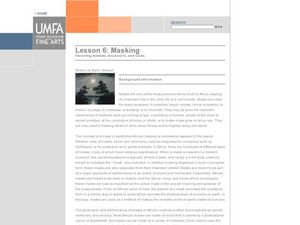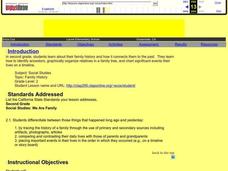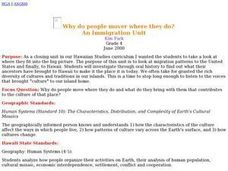University of California
Migration of Early Humans: Evidence and Interpretations
While much of prehistory is cloaked in mystery, ancient ancestors left evidence in DNA, languages, and materials from their time. Using photographs of items such as cave paintings and ancient tools, as well as maps of linguistic patterns...
Curated OER
American Heritage Themes
Pupils define freedom, unity, progress, and responsibility in relation to American Heritage. They explore the origin of how American Heritage was developed and ways in which they can continue it today. They also determine ways they can...
Curated OER
Coming to America
Through this set of three lessons about Ellis Island, class members will learn about why immigrants came to the United States, find out about the difficulties that went along with coming to America, become familiar with the immigration...
Core Knowledge Foundation
Isn’t It Exciting? (The American Industrial Revolution and Urbanization)
America was built on the ingenuity, work ethic, and foresight of our ancestors. Sixth graders learn about the complex Gilded Age in American history, including the prominent inventors and captains of industry, and how they all connect...
Constitutional Rights Foundation
Ellis Island—The “Golden Door” to America
Are you one of the 100 million Americans whose ancestors passed through the doors of Ellis Island? Learn about the historic entry point for immigrants in the late 19th and early 20th centuries with an informative reading passage. After...
PBS
Family History: On Your Honor
What is your history? Scholars work with their own families to create a unique story of the courage and bravery of their ancestors. The third and final part of the series culminates in a creation of not just a family history, but a...
NET Foundation for Television
1850-1874 Homestead Act Signed: Who were the Settlers?
Life in the great, wide-open spaces of the West! Scholars analyze the reasons behind the vast movement to the Great Plains after the passing of the Kansas-Nebraska Act and the Homestead Act. Using photographic, document, map, video, and...
Curated OER
Finding Your Spot in the World
Learners learn the concept of movement by locating their house and the houses of their ancestors.
Curated OER
Making Peace
Students examine how African societies view their family and ancestors and settle disputes. They create a spirit doll, and role-play conflict resolution using the ancestor figure dolls.
Curated OER
Garb and Grub Across the Globe
First graders discuss what part of the world their ancestors came from. They locate the locations on a map and discuss the differences and similarities of each continent and their people. They become familiar with the traditional...
Curated OER
Pilgrim Heritage and Ancestory
Students explore immigrants and immigration to the United States. They define and explain their definition of the term pilgrim. Students evaluate the goals of their ancestors as they arrived in America. Students research and design a...
Curated OER
Prehistory: Our Ancestors Emerge
In this prehsitory learning exercise, students read a 3-page article about antropological finds and then respond to 2 short answer questions based on the article.
Curated OER
Masking: Honoring Animals, Ancestors, and Gods
Students analyze the role of masks in African culture. In this African masks lesson, students read about the importance and meaning of imagery of African masks. Students observe animals in local ecosystems and create a mask combining the...
Curated OER
We the People (Cultural Research)
Fourth graders conduct cultural research, collect oral histories using tape recorders and cameras, and share their ancestral heritage with classmates through family heirlooms and ethnic foods.
Curated OER
American History: Finding your Voice
Students are able to write a speech and create a slogan through analysis of current issues articles dealing with pesticide use. They put themselves in the position of one of the workers affected by the story they read.
Curated OER
Family Tree Community Project
Fifth graders answer questions such as: Where does my family come from? What was it like for my ancestors to grow up as America developed? What differences in society were present then? What was similar to today? students conduct...
Curated OER
Finding Your Spot in the World
Students investigate a world map, a United States map, a state map, a county map and a city map. They locate each student's house on the city map and put a length of yarn from their house to a country of one of their ancestors.
Curated OER
Frank Sadorus Collection: Photographic Family Tree Activity
Young scholars collect and place photographs of their parents, grandparents, etc., in a family tree-like chart or positioned by generation. They find out more about the occupations and lives of their ancestors.
Curated OER
We Are Family
Second graders research their family history and how it connects them to the past. They identify their ancestors, graphically organize relatives in a family tree, and chart significant events in their lives on a timeline.
Curated OER
Discovering Your Heritage
Students interview a family member about their heritage. They listen to and record part of their family's oral history. Students also create and label a family tree going back a minimum of two generations and compare and contrast...
Curated OER
Why do people mover where they do?
Students read factual stories of migration to Hawaii, analyze and explain push and pull factors, interview parents about their cultural heritage, identify countried of origin of their ancestors, graph migration patterns on an world map,...
Curated OER
Journeys...The Voices of Change
Students trace the immigration patterns of their ancestors. They plot information on a world map, develop a timeline of target immigration patterns, research and write a report on immigration and participate in a class play.
Smithsonian Institution
Ceramica de los Ancestros
Scholars join a field expedition team to unearth a plethora of treasures from Central America. Artifacts listed in alphabetical order come with an informational blurb and a picture designed for participants to color. Activity pages...
DocsTeach
Evaluating a Needlework Sampler as Historical Evidence
Needlework isn't just for home decor; it can also help record family history. Academics analyze a needlework sampler to understand how they were used to record marriages and births. The activity includes a series of written questions,...
Other popular searches
- Family Tree Ancestors
- Common Ancestors
- Families and Ancestors
- Chinese Ancestors
- Who Are My Ancestors
- Trace Your Ancestors
- Our Past Ancestors
- Social Studies and Ancestors
- Creative Writing Ancestors
- Immigration and Ancestors
- Ancestors Coming to America
- Human Ancestors

























